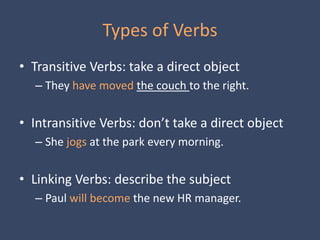Verbs
- 2. What’s a Verb? • The part of speech that expresses existence, action, state, or occurence. – There is a rusted hinge in that door. – The girl is jumping rope. – Puppies need a lot of care and attention. – Her last birthday fell on Monday.
- 3. Types of Verbs • Transitive Verbs: take a direct object – They have moved the couch to the right. • Intransitive Verbs: don’t take a direct object – She jogs at the park every morning. • Linking Verbs: describe the subject – Paul will become the new HR manager.
- 4. Verb Tenses • A basic sentence in English has the following structure: – Subject + Verb + (Object) + (Complement) • The verb tense is the way the verb changes to describe the time when the action took place.
- 5. Verb Tenses Examples • She works at HP. • She is working in a big acquisition project. • She worked at Intel two years ago. • She has worked in three big companies. • She will travel to Brazil on business next month. • She had started working at Amazon by 2001. • As you can see in those examples the verb changes according to its tense.




